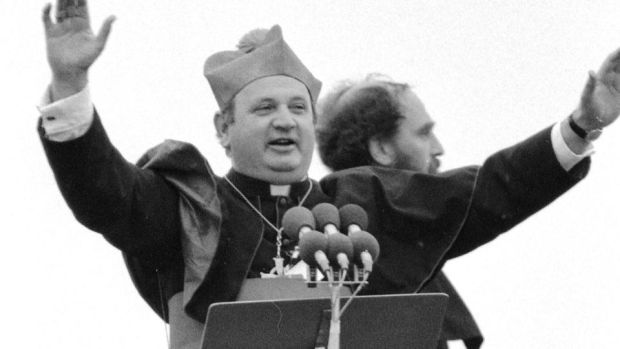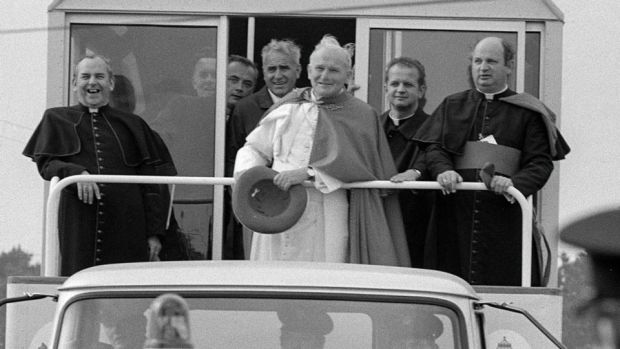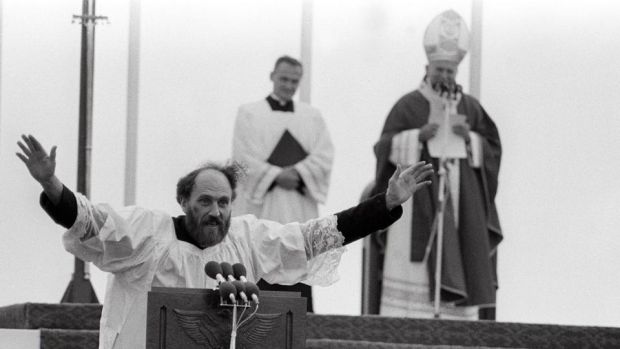The Priest Who Shattered My Faith in the Catholic Church
By Professor Chris Fitzpatrick
For as long as I can remember, the archaic “suffer”, in the biblical imperative “Suffer little children, and forbid them not to come to me”, had carried with it an unintentionally sinister undertone. This was a priest who for me and countless others had embodied Catholic virtue – an image of Christ, beard and all. The innocence of my childhood was finally destroyed. The rug had been whipped from under my feet, and what was broken has never been fixed. Although newspapers variously referred to him by his civilian name, John Boland, or his religious name, Fr Dominic Savio, he was Domo to the raggle-taggle schoolboys of Dublin’s northside inner city who played on his football teams, served his Masses or came down to the friary on Church Street after school for the bowls of tinned pears and ice cream that he brought from the refectory fridge, or the sweets and oranges that he magicked out of the dark recesses of his long brown habit – including, to the delight of all, his hood. His left arm was paralysed as a result of a birth injury, and he had told us on many occasions that photographs of him holding a wafer and empty chalice had to be sent to Rome for him to be passed fit to take holy orders. Despite his disability he could play the piano (Fats Domino and The Beatles) and the mouth organ and could juggle small apples and oranges one-handed. He viewed his physical vulnerability as a blessing that brought him closer to those in need of spiritual succour – and to God. Along with the sweets and fruit that he secreted in his habit he sometimes had one of Padre Pio’s mittens or a relic of the true Cross. He visited (and reputedly cured) the sick, anointed the dying, and blessed new cars and house extensions and throats prophylactically. When he visited homes he would lay his right hand gently on the bowed heads of all who stood in the hallway, bestowing blessings as we lined up to say goodbye. He was especially devoted to the Blessed Virgin Mary and to his own widowed mother. Mothers loved him. He also loved their young sons. He hinted that they might join up some day. He regaled his audiences with hilarious accounts of the high jinks that he and his classmates got up to when they were away studying for the priesthood – all good, cleanfun. Because he loved soccer, and gave their sons the chance to play with leather footballs rather than plastic ones, fathers liked him, too. He was wary of daughters and older brothers who were interested in girls, and they were wary of him and kept their distance. Young boys loved him. Although he was a priest, he was like one of us. He had a good right foot and could bend a ball long before David Beckham could. He often told us about his namesake, Dominic Savio, who even as a very young boy wanted to be a saint. (We didn’t.) Despite his piety and otherworldly powers of healing, he was also at times anarchic and didn’t seem to mind when we came back from Lourdes with metal combs we’d bought there that were in the shape of flick knives but with a picture of Our Lady on the handles. Despite his devotion to Our Lady he used one of them to comb his own hair, as a joke. Although mothers thought it a little disrespectful, they let it pass. “Boys will be boys,” he would impishly pronounce. “How innocent he is,” they said, and forgot all about it. Because he had taken the vow of poverty (along with those of obedience and chastity) he could not own a car. An almost telepathic consensus, among the working-class women who idolised him, that his ministry should not be restricted by a lack of transport led to the purchase of a small car, along with the tax and insurance, for him to use. Paid for through raffles, cake sales and whip-rounds, the car was parked in the nominal owner’s drive, not far from the friary. As a named driver the Capuchin could now travel far and wide – without breaking his vows. Not even the canon lawyers could catch him. Parents considered him both harmless and trustworthy, and they willingly entrusted their children to him.
Behind the smokescreen of vestments and incense, like many of his ilk, he preyed on his defenceless charges. Convicted of nine counts of indecent assault against one victim, he acknowledged up to 100 offences against 20 children and was judged to pose a significant risk to boys between the ages of nine and 14. He is now dead, and his name is rarely mentioned. This story is, tragically, not unusual. Dominic Savio was cut from the same cloth as the outwardly decent and charming Christian Brother – described by Fintan O’Toole last month – who abused children in Belfast. There are thousands of similar stories, replicated in almost every diocese on every continent. They are now part of the narrative of the Catholic Church, better known to many than the liturgy of the Mass. We can but imagine the physical, mental and spiritual pain suffered by those who were molested and raped and had their lives destroyed by paedophile clerics. They say that all history is local and that one’s view of the world is predominantly shaped by personal experiences and by the individual stories of others. And so the shock waves of what Dominic Savio and others did travelled far beyond those whom they most grievously injured – and affected us all. The inadequacy of the church’s response to the crisis added insult to injury. Church attendance has plummeted in two generations, starting with mine – part of the collateral damage. And we were the lucky ones. We only lost our faith in this church, and our innocence. Vocations have also dwindled to a trickle. Even committed parents dissuade their children from any thoughts they might have of entering the religious life. Who would blame them? Seeing Bishop Eamonn Casey and Fr Michael Cleary on reruns of Reeling in the Years, leading the papal singalong in Galway, still rankles those of us who remember being cynically duped in another context. Some will defend the church, of course, saying that a few rotten apples don’t necessarily spoil the barrel and that lots of organisations have their share of deviants and hypocrites. That may be true. The difference is, however, that the likes of the Irish Amateur Swimming Association, the BBC and Hollywood never pontificated on how we should live our intimate lives. Nor did they (including the perpetrators among them) ever claim to have sacramental powers, the forgiveness of sins among them. To borrow a phrase from Matthew, in hunting for specks of dust in the eyes of others, the church missed a plank in its own. A legacy of corporate cover-ups, combined with an often deplorable lack of empathy with and compassion for the victims of sexual crimes has seriously eroded the moral authority of the Catholic Church and cast a long shadow over its model of governance and canon laws. Placed alongside the church’s hard-line views on such issues as contraception, homosexuality, divorce, clerical celibacy and women priests – why not women bishops and popes? – it would make you wonder if the powers that be are living on the same planet as us mere mortals. Similar thoughts must cross the minds of the many decent priests, nuns and brothers who do their very best and now find themselves in an almost impossible position, trapped between an out-of-touch, inflexible hierarchy and oppressive public suspicion.
And although the foundations are still shaking, the church doesn’t seem to get it. Unable or unwilling to move, it seems increasingly stuck in a time warp. Recent pronouncements on the HPV vaccine are one example of this. Decrying a role for condoms in halting the spread of Aids is another. So is equating the rights of an embryo and a woman. These views are not only morally and medically wrong but also dangerous. The Ireland of the 21st century is a modern, secular, pluralist republic. As citizens we must respect the rights of others and draw distinctions between private and public morality, between the affairs of personally held religious belief systems and the affairs of state. The role and influence of religion in modern civil society needs a more nuanced reinterpretation. The idea of avowedly celibate men, deliberating obsessively over the small print of consensual sexual morality and “sins of impurity” – from the glittering splendour of the Vatican all the way down to the dark recesses of the confession box – seems disturbingly dysfunctional. Male hegemony is not some God-given right; I have never seen it written on any tablets of stone. It is a form of abuse, just like abuse based on race or sexual orientation. It has, however, been a problem in the church for a very long time, superimposed on historical social norms – bound up with politics and power. It should no longer be part of the subtext of what it means to be a Catholic. Were Jesus to arrive for the first time now he would, I’m sure, be an equal-opportunity-promoting Messiah with a gender-balanced, diverse band of Apostles and with less dogmatic views on human nature than many who currently claim to speak on his behalf. Like many Catholics, I voted for marriage-equality in May 2015. I will also vote for the repeal of the Eighth Amendment to the Constitution; I suspect many Catholics will do likewise. The time for another reformation is long overdue. Maybe, 500 years later, it’s time for another Martin Luther – preferably a woman – to nail her theses to the doors of St Peter’s. And if Jesus is around, maybe he’d clear out the temple again. Chris Fitzpatrick is a consultant obstetrician and gynaecologist, and former master, at Coombe Women & Infants University Hospital and clinical professor at University College Dublin school of medicine. Earlier this year he resigned from the project board overseeing the National Maternity Hospital’s move to the St Vincent’s University Hospital campus because of the Catholic ethos of St Vincent’s Healthcare Group, which was to have a role in the ownership and governance of the new hospital. He is a Catholic
|
.
Any original material on these pages is copyright © BishopAccountability.org 2004. Reproduce freely with attribution.


